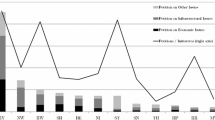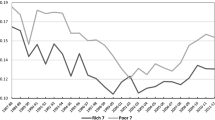Abstract
Though the relationship between local government structure and expenditure has received considerable attention, there is little consensus as to how the features of representative government affect local expenditure. An exception is city council size, which has consistently been found to be positively related to spending. Previous results rely on cross-sectional estimation which may be subject to omitted variable bias. This paper analyzes three components of municipal governments—the form of government, the size of the city council, and the election method of city councilors. Once fixed effects estimation is employed, the positive relationship between city council size and expenditure disappears.
Similar content being viewed by others
References
Alesina, A., Baqir, R., & Easterly, W. (1999). Public goods and ethnic divisions. The Quarterly Journal of Economics, 114, 1243–1284.
Baqir, R. (2002). Districting and government overspending. Journal of Political Economy, 110, 1318–1354.
Booms, B. H. (1966). City governmental form and public expenditure levels. National Tax Journal, 19, 187–199.
Buchanan, J. M., & Tullock, G. (1962). The calculus of consent. Ann Arbor: The University of Michigan Press.
Bradbury, J. C., & Crain, W. M. (2001). Legislative organization and government spending: cross-country evidence. Journal of Public Economics, 82, 309–325.
Bradbury, J. C., & Stephenson, E. F. (2003). Local government structure and public expenditures. Public Choice, 115, 186–198.
Census Bureau (2002). Government organization. Census of Governments.
Deno, K. T., & Mehay, S. L. (1987). Municipal management structure and fiscal performance: do city managers make a difference? Southern Economic Journal, 53, 627–642.
Fahy, C. (1998). The choice of local government structure in Massachusetts: a historical public choice perspective. Social Science Quarterly, 79, 433–444.
Farnham, P. G. (1990). The impact of citizen influence on local government expenditure. Public Choice, 64, 201–212.
Gilligan, T. W., & Matsusaka, J. G. (2001). Fiscal policy, legislature size, and political parties: evidence from state and local governments in the first half of the 20th century. National Tax Journal, 54, 57–82.
International City/County Management Association (2004). The municipal yearbook.
Langbein, L. I., Crewson, P., & Brasher, C. N. (1996). Rethinking ward and at-large elections in cities: total spending, the number of locations of selected city services, and policy types. Public Choice, 88, 275–293.
Luttmer, E. F. P. (2001). Group loyalty and the taste for redistribution. The Journal of Political Economy, 109, 500–528.
Mehay, S. L., & Seiden, K. P. (1986). Municipal residency laws and local public budgets. Public Choice, 48, 27–35.
Morgan, D. R., & Pelissero, J. P. (1980). Urban policy: does political structure matter? American Political Science Review, 74, 999–1006.
Reed, W. R. (2006). Democrats, republicans, and taxes: evidence that political parties matter. Journal of Public Economics, 90, 725–750.
Reid, G. J. (1991). Tests of institutional versus non-institutional models of local public expenditure determination. Public Choice, 70, 315–333.
Sass, T. R. (1991). The choice of municipal government structure and public expenditures. Public Choice, 72, 71–87.
Southwick, L. Jr. (1997). Local government spending and at-large versus district representation; do wards result in more ‘pork’? Economics and Politics, 9, 173–203.
Studenmund, A. H. (1997). Using econometrics: a practical guide (3rd ed.). Reading: Addison-Wesley.
Tiebout, C. M. (1956). A pure theory of local expenditures. Journal of Political Economy, 64, 416–424.
Weingast, B. R., Shepsle, K. A., & Johnsen, C. (1981). The political economy of benefits and costs: a neoclassical approach to distributive politics. Journal of Political Economy, 89, 642–664.
Zax, J. S. (1989). Initiatives and government expenditures. Public Choice, 63, 267–277.
Author information
Authors and Affiliations
Corresponding author
Rights and permissions
About this article
Cite this article
MacDonald, L. The impact of government structure on local public expenditures. Public Choice 136, 457–473 (2008). https://doi.org/10.1007/s11127-008-9308-8
Received:
Accepted:
Published:
Issue Date:
DOI: https://doi.org/10.1007/s11127-008-9308-8




